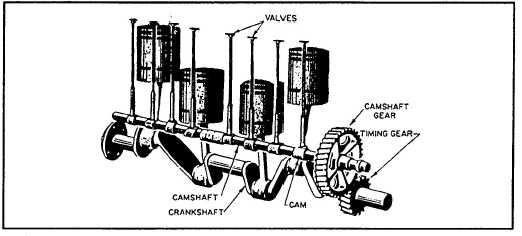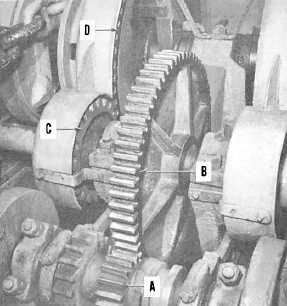Figure 6-13.—Automobile valve gear.
The total, or overall, theoretical mechanical
advantage of a compound machine is equal to the
product of the mechanical advantages of the
several simple machines that make it up. In this
case you considered the winch as two machines—
one having a mechanical advantage of 6 and the
other a mechanical advantage of 2. Therefore, the
overall theoretical mechanical advantage of the
winch is 6 x 2, or 12. Since friction is always
present, the actual mechanical advantage may be
only 7 or 8. Even so, by applying a force of 100
pounds on the handle, you could lift a load of 700
to 800 pounds.
CAM
You use gears to produce circular motion.
However, you often want to change rotary motion
into up-and-down, or linear, motion. You can use
cams to do this. For example, in figure 6-12 the
gear turns the cam shaft. A cam is keyed to the
shaft and turns with it. The design on the cam has
an irregular shape that moves the valve stem up
and down. It gives the valve a straight-line motion
as the cam shaft rotates.
When the cam shaft rotates, the high point
(lobe) of the cam raises the valve to its open
position. As the shaft continues to rotate, the high
point of the cam passes, lowering the valve to a
closed position.
A set of cams, two to a cylinder, driven by
timing gears from the crankshaft operate the
exhaust and intake valves on the gasoline
automobile engine as shown in figure 6-13. We use
cams in machine tools and other devices to make
rotating gears and shafts do up-and-down work.
ANCHOR WINCH
One of the gear systems you’ll get to see
frequently aboard ship is that on the anchor
winch. Figure 6-14 shows you one type in which
you can readily see how the wheels go around. The
winch engine or motor turns the driving gear (A).
This gear has 22 teeth, which mesh with the 88
teeth on the large wheel (B). Thus, you know that
the large wheel makes one revolution for every
four revolutions of the driving gear (A). You get a
4-to-1 theoretical mechanical advantage out of
that pair. Secured to the same shaft with B is the
small spur gear (C), covered up here. The gear (C)
has 30 teeth that mesh with the 90 teeth on the
large gear (D), also covered up.
Figure 6-14.—An anchor winch.
6-7



